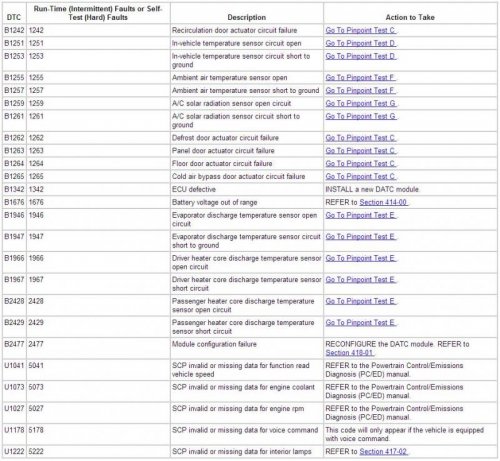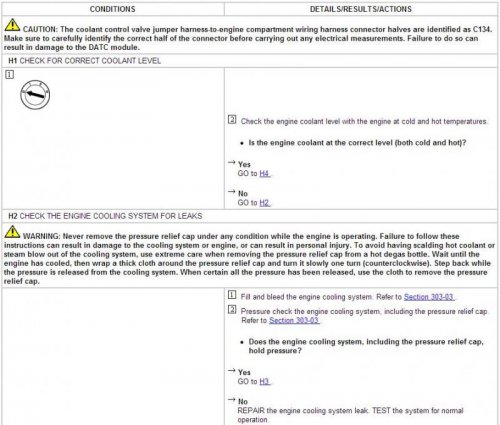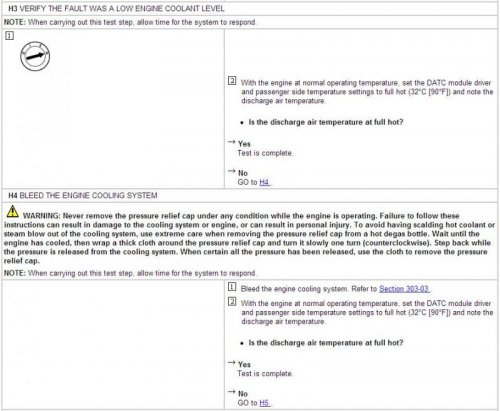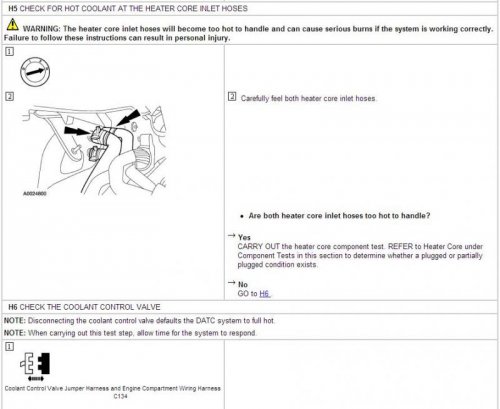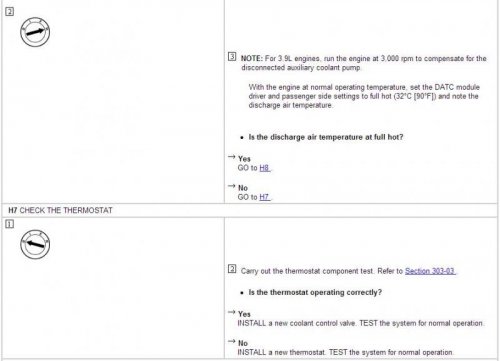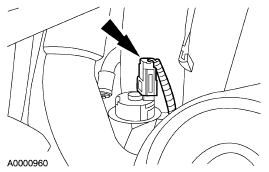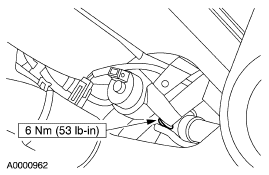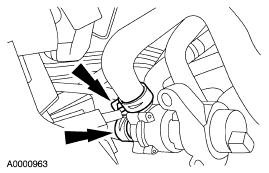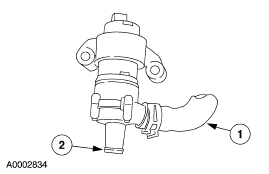RigsLS
Dedicated LVC Member
- Joined
- Mar 10, 2012
- Messages
- 7,756
- Reaction score
- 532
2000-2004 Service Information
SECTION 412-00: - Climate Control System - General Information
Dual Automatic Temperature Control (DATC) Module Description
The DATC system automatically maintains a selected temperature for vehicle interior comfort and regulates the volume of airflow between the instrument panel registers, floor ducts, windshield defroster nozzle, and side window demisters. The system will automatically select between fresh and recirculated air with an optional manual override. The DATC system will also include a manual A/C override, blower speed override, and airflow direction overrides.
The dual temperature zone feature provides the driver and the front seat passenger with their own independent temperature set points. The DATC system provides both the driver and front seat passenger with their selected temperature for interior comfort. In situations where the difference between the driver and the front seat passenger set points are very large, the DATC will tend to favor the driver's setting and make the front seat passenger as comfortable as possible.
The driver and front seat passenger will not have independent air distribution mode or fan controls so the system is dual temperature only. In some cases the passenger temperature set point may influence the air distribution mode or blower speed in automatic mode.
System Air Flow
AUTO
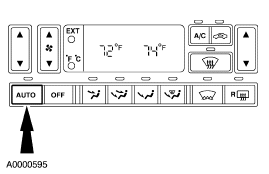
When AUTO is selected:
OFF
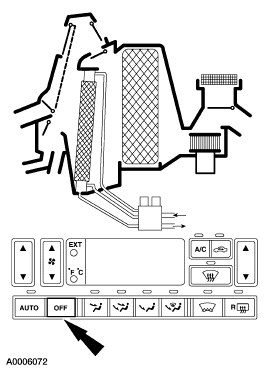
When OFF is selected:
PANEL
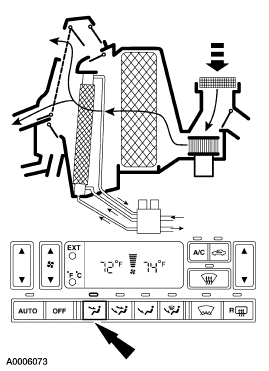
When PANEL is selected:
PANEL/FLOOR
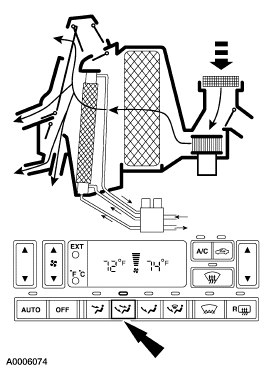
When PANEL/FLOOR is selected:
FLOOR
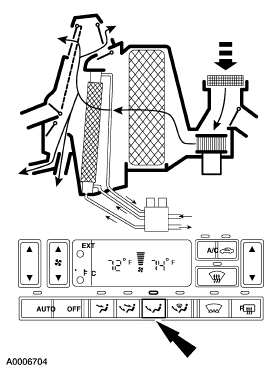
When FLOOR is selected:
FLOOR/DEFROST
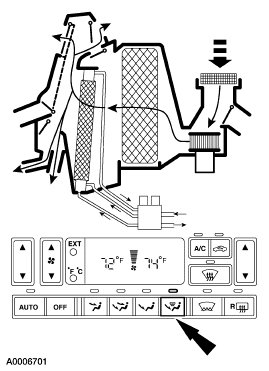
When FLOOR/DEFROST is selected:
DEFROST
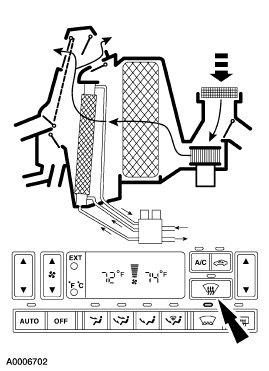
When DEFROST is selected:
Climate Control System Electrical Components—Directly Linked to DATC Module
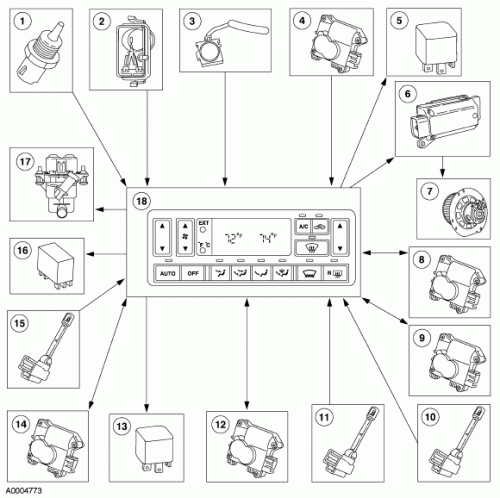
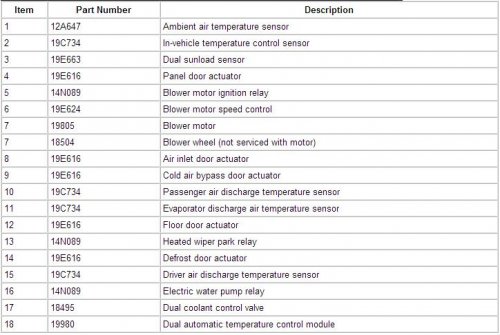
Climate Control System Components — J1850 Communications Network (SCP) Linked
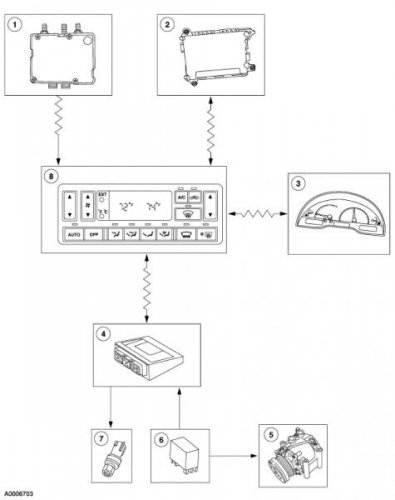













SECTION 412-00: - Climate Control System - General Information
Dual Automatic Temperature Control (DATC) Module Description
The DATC system automatically maintains a selected temperature for vehicle interior comfort and regulates the volume of airflow between the instrument panel registers, floor ducts, windshield defroster nozzle, and side window demisters. The system will automatically select between fresh and recirculated air with an optional manual override. The DATC system will also include a manual A/C override, blower speed override, and airflow direction overrides.
The dual temperature zone feature provides the driver and the front seat passenger with their own independent temperature set points. The DATC system provides both the driver and front seat passenger with their selected temperature for interior comfort. In situations where the difference between the driver and the front seat passenger set points are very large, the DATC will tend to favor the driver's setting and make the front seat passenger as comfortable as possible.
The driver and front seat passenger will not have independent air distribution mode or fan controls so the system is dual temperature only. In some cases the passenger temperature set point may influence the air distribution mode or blower speed in automatic mode.
System Air Flow
AUTO

When AUTO is selected:
- The temperature control setting(s) are manually set to the desired setting(s).
- The air inlet door actuator is automatically controlled by the DATC module, based on the temperature setting(s), but can be manually overridden by selecting the recirculation button.
- The panel door, floor door, defrost door and cold air bypass door actuators are automatically controlled by the DATC module based on the temperature setting(s), but can be manually overridden by selecting any of the air distribution buttons
- The dual coolant control valve is automatically controlled by the DATC module based on the temperature setting(s).
- The A/C compressor is automatically controlled by the DATC module based on the temperature setting(s), but can be manually overridden by selecting the A/C button. The A/C compressor will not operate if the outside temperature is lower than approximately 2°C (35°F).
- The blower motor is on. The blower motor speed is automatically controlled by the DATC module based on the temperature setting(s), but can be manually overridden by adjusting the blower speed rocker button.
OFF

When OFF is selected:
- The air inlet door actuator positions the air inlet door to close off outside air from entering the passenger compartment.
- The floor door actuator positions the floor door in the open position, and the panel door actuator, defrost door actuator, and cold air bypass door actuator position the panel door, defrost door, and cold air bypass door in the closed positions. This closes off airflow to the defrost duct, the side window demisters, the floor duct and the instrument panel A/C registers.
- The dual coolant control valve is in the closed position, preventing the flow of hot coolant to the heater core.
- The blower motor is off.
PANEL

When PANEL is selected:
- The Recirc request button is enabled. If the Recirc request button is selected (indicator on), the air inlet door actuator positions the air inlet door to close off outside air from entering the passenger compartment. If the Recirc request button is not selected (indicator off), the air inlet door actuator positions the air inlet door to admit only outside air into the passenger compartment.
- The panel door actuator positions the panel door in the open position and the floor door and defrost door actuators position the floor door and defrost door in the closed position, directing airflow to the instrument panel A/C registers. The cold air bypass door actuator is automatically controlled by the DATC module based on the temperature setting(s).
- The dual coolant control valve is automatically controlled by the DATC module based on the temperature setting(s).
- The A/C request button is enabled. When the A/C request button is selected (indicator on), the A/C compressor will operate if the outside air temperature is above approximately 2°C (35°F). When the A/C request button is not selected (indicator off), the A/C compressor will not operate and the air cannot be cooled below the outside temperature
- The blower motor is on.
PANEL/FLOOR

When PANEL/FLOOR is selected:
- The Recirc request button is enabled. If the Recirc request button is selected (indicator on), the air inlet door actuator positions the air inlet door as to close off outside air from entering the passenger compartment. If the Recirc request button is not selected (indicator off), the air inlet door actuator positions the air inlet door to admit only outside air into the passenger compartment.
- The panel door and floor door actuators position the panel door and floor door in the open position and the defrost door actuator positions the defrost door in the closed position, directing airflow to the instrument panel A/C registers and the floor duct. The cold air bypass door actuator is automatically controlled by the DATC module based on the temperature setting(s).
- The dual coolant control valve is automatically controlled by the DATC module based on the temperature setting(s).
- The A/C request button is enabled. When the A/C request button is selected (indicator on), the A/C compressor will operate if the outside air temperature is above approximately 2°C (35°F). When the A/C request button is not selected (indicator off), the A/C compressor will not operate and the air cannot be cooled below the outside temperature.
- The blower motor is on.
FLOOR

When FLOOR is selected:
- The Recirc request button is enabled. If the Recirc request button is selected (indicator on), the air inlet door actuator positions the air inlet door to close off outside air from entering the passenger compartment. If the Recirc request button is not selected (indicator off), the air inlet door actuator positions the air inlet door as to admit only outside air into the passenger compartment. The DATC will automatically revert to the outside air position after approximately 1 to 4 minutes to prevent window fogging.
- The floor door actuator positions the floor door in the open position and the panel door and defrost door actuators position the panel door and defrost door in the closed position, directing airflow to the floor duct. A small amount of airflow from the outboard instrument panel A/C registers will be present. The cold air bypass door actuator is automatically controlled by the DATC module based on the temperature setting(s).
- The dual coolant control valve is automatically controlled by the DATC module based on the temperature settings.
- The A/C request button is enabled. When the A/C request button is selected (indicator on), the A/C compressor will operate if the outside air temperature is above approximately 2°C (35°F). When the A/C request button is not selected (indicator off), the A/C compressor will not operate and the air cannot be cooled below the outside temperature.
- The blower motor is on.
FLOOR/DEFROST

When FLOOR/DEFROST is selected:
- The Recirc request button is enabled. If the Recirc request button is selected (indicator on), the air inlet door actuator positions the air inlet door to close off outside air from entering the passenger compartment. If the Recirc request button is not selected (indicator off), the air inlet door actuator positions the air inlet door as to admit only outside air into the passenger compartment. The DATC will automatically revert to the outside air position after approximately 1 to 4 minutes to prevent window fogging.
- The floor door and defrost door actuators position the floor door and defrost door in the open position and the panel door actuator positions the panel door in the closed position, directing airflow to the floor duct, the windshield defroster ducts, and the side window demisters. A small amount of airflow from the outboard instrument panel A/C registers will be present. The cold air bypass door actuator is automatically controlled by the DATC module based on the temperature setting(s).
- The dual coolant control valve is automatically controlled by the DATC module based on the temperature settings.
- The A/C request button is enabled. When the A/C request button is selected (indicator on), the A/C compressor will operate if the outside air temperature is above approximately 2°C (35°F). When the A/C request button is not selected (indicator off), the A/C compressor will not operate and the air cannot be cooled below the outside temperature
- The blower motor is on.
DEFROST

When DEFROST is selected:
- The Recirc request button is disabled. The air inlet door actuator positions the air inlet door to admit only outside air into the passenger compartment.
- The defrost door actuator positions the defrost door in the open position and the panel door, floor door, and cold air bypass door actuators position the panel door, floor door, and cold air bypass door in the closed position, directing airflow to the windshield defroster ducts and the side window demisters. A small amount of airflow from the outboard instrument panel A/C registers will be present
- The dual coolant control valve is automatically controlled by the DATC module based on the temperature settings.
- The A/C request button is disabled. To reduce fogging, the A/C compressor will operate if the outside air temperature is above approximately 2°C (35°F).
- The blower motor is on
Climate Control System Electrical Components—Directly Linked to DATC Module


Climate Control System Components — J1850 Communications Network (SCP) Linked





